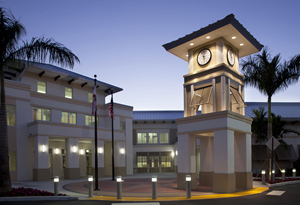Wellington’s Equestrian Preserve Committee heard a presentation Wednesday from Utilities Director Shannon LaRocque about improvements and renovations to the village’s utilities system, enabling better use of its water reclamation program by applying it in large areas such as polo fields.
LaRocque said part of the utilities system, besides providing potable water and wastewater treatment, is to provide a reclaimed water program.
“Not all utilities provide reclaimed water services, but I think it’s very unique that the Village of Wellington has the ability to provide a robust reclaimed service,” she said, explaining that reclaimed water has the potential to serve large parts of the Equestrian Preserve Area that sometimes suffer through periods of drought.
“Our vision, obviously, is to provide the best water, the best service and best environmental stewardship,” LaRocque said. “Over my 29-year career, 90 percent of it has been in the water industry, and I love the water industry.”
The village’s utility has about a $12.2 million operations budget this year, with a $4.6 million capital outlay budget.
“Looking forward, we have more than $60 million we’ll be spending,” LaRocque said, explaining that although the village as an incorporated entity is young compared with most municipalities, the water utility has been operating for the past 40 years. “We’re not necessarily in a large growth mode. What we are moving into is a sustainability mode, which means we’re doing a lot of replacement of existing infrastructure.”
With about 20,000 customer accounts over 39 square miles and a total value of about $400 million, she said the village’s utility is relatively small.
“While it is a small utility, it is a very progressive utility,” LaRocque said.
The utility includes a reverse osmosis plant and an old lime softening plant, which will be replaced sometime in the future with membrane technology.
The wastewater treatment plant on Pierson Road is rated at 6.5 million gallons a day, and can treat about 4.1 million gallons of reclaimed water a day.
“We’re getting ready to expand that,” LaRocque said. “Interestingly enough, although we can treat all that water, a very small percentage of that water is utilized within the village. It’s only utilized within public areas, rights of way, parks and things like that.”
Reclaimed water is water that has been treated by the wastewater plant. It is not fit for consumption, but does well for irrigation purposes. The nice thing about reclaimed water is that there are no restrictions on its use, including during drought, LaRocque said.
“The South Florida Water Management District is the entity that regulates when water restrictions go into play in our area,” she said. “The Village of Wellington cannot make laws that are less stringent than those regulations.”
As Palm Beach County’s former water utilities director, LaRocque pointed out that the county reuses 100 percent of its reclaimed water, largely on golf courses.
“None of those golf courses had water restrictions during that period several years ago when things were very, very dry,” she said.
Part of her strategy with Wellington is to embark on a master plan for the reclaimed water system. “We’re spending operational dollars and capital dollars to keep these systems in place, and 90 percent of it is going down the deep injection well, so there is a huge opportunity, for polo especially, to utilize some of the reclaimed water,” LaRocque said.
Committee Chair Jane Cleveland pointed out that every sand ring in Wellington also gets watered.
LaRocque said providing reclaimed water gets a little more challenging in residential areas due to infrastructure improvements and getting people to pay for a hookup.
“Reused water at its commodity price is not cost-effective, so what we want to do is pick up the large customers,” she said. “While Wellington is not growing, there are certainly areas, and high-end areas like our equestrian areas, that are starting to say, ‘Hey, we want potable water.’”
At a meeting with SFWMD officials on Wednesday, LaRocque learned that while the water district controls and limits how much water Wellington can have, for every gallon of reclaimed water that it can utilize, the village can benefit because it is not included in the allocation.
“That was very encouraging to hear, because as I gather past history, there has been a little apprehension as to whether or not reclaimed water was going to be utilized in areas outside public uses,” LaRocque said.
One of the uses that the village’s reclaimed water goes to now is the Peaceful Waters Sanctuary in Village Park near the water reclamation plant.
“That’s a beautiful little wetland, and we dispose of some of our reuse water there, so it’s an environmental benefit, and we also get a benefit from the district with respect to using that to get more surficial water,” LaRocque said, adding that it’s similar to the 365-acre Wellington Environmental Preserve at the Marjory Stoneman Douglas Everglades Habitat, which also receives some of the village’s reused water.








